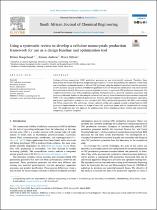 ResearchSpace
ResearchSpace
Using a systematic review to develop a cellulose nanocrystals production framework for use as a design baseline and optimization tool
JavaScript is disabled for your browser. Some features of this site may not work without it.
- ResearchSpace
- →
- Research Publications/Outputs
- →
- Journal Articles
- →
- View Item
| dc.contributor.author |
Roopchund, R

|
|
| dc.contributor.author |
Andrew, Jerome E

|
|
| dc.contributor.author |
Sithole, B

|
|
| dc.date.accessioned | 2024-02-05T07:16:18Z | |
| dc.date.available | 2024-02-05T07:16:18Z | |
| dc.date.issued | 2023-04 | |
| dc.identifier.citation | Roopchund, R., Andrew, J.E. & Sithole, B. 2023. Using a systematic review to develop a cellulose nanocrystals production framework for use as a design baseline and optimization tool. <i>South African Journal of Chemical Engineering, 44.</i> http://hdl.handle.net/10204/13555 | en_ZA |
| dc.identifier.issn | 1026-9185 | |
| dc.identifier.uri | https://doi.org/10.1016/j.sajce.2023.03.006 | |
| dc.identifier.uri | http://hdl.handle.net/10204/13555 | |
| dc.description.abstract | Various cellulose nanocrystals (CNC) production processes are not systematically reviewed. Therefore, there lacks a basis for future CNC process designs and optimizations. To solve this problem, the objective of this study was to perform a systematic review of selected CNC processes using the preferred reporting items for systematic review and meta-analysis protocols (PRISMA-P) guidelines to review the process information from each selected literature item to identify the common process segments to create a segmented CNC production framework. The results revealed four major CNC production segments: feed pretreatment, chemical treatment, separation, and product purification. Statistical data analysis indicated that varying forms of mechanical pretreatment comprised 100% of the lignocellulosic feedstock pretreatment. However, the most common chemical treatment, separation, and product purification options are acid hydrolysis (60–75%), mechanical separation (40–60%), and washing (20–50%), respectively. The technology options explored within each segment created a design basis for CNC production improvements to assist the design of new CNC production plants and the optimization of existing ones. The model can also help improve the understanding of the minimum protocol content and improve the competency of process designers. | en_US |
| dc.format | Fulltext | en_US |
| dc.language.iso | en | en_US |
| dc.relation.uri | https://www.sciencedirect.com/science/article/pii/S1026918523000240 | en_US |
| dc.source | South African Journal of Chemical Engineering, 44 | en_US |
| dc.subject | Cellulose nanocrystals | en_US |
| dc.subject | Biorefinery processes | en_US |
| dc.subject | Process optimization | en_US |
| dc.subject | Segmented production | en_US |
| dc.title | Using a systematic review to develop a cellulose nanocrystals production framework for use as a design baseline and optimization tool | en_US |
| dc.type | Article | en_US |
| dc.description.pages | 344-355 | en_US |
| dc.description.note | © 2023 The Author(s). Published by Elsevier B.V. on behalf of Institution of Chemical Engineers. This is an open access article under the CC BY license (http://creativecommons.org/licenses/by/4.0/). | en_US |
| dc.description.cluster | Chemicals | en_US |
| dc.description.impactarea | BT Biorefinery | en_US |
| dc.identifier.apacitation | Roopchund, R., Andrew, J. E., & Sithole, B. (2023). Using a systematic review to develop a cellulose nanocrystals production framework for use as a design baseline and optimization tool. <i>South African Journal of Chemical Engineering, 44</i>, http://hdl.handle.net/10204/13555 | en_ZA |
| dc.identifier.chicagocitation | Roopchund, R, Jerome E Andrew, and B Sithole "Using a systematic review to develop a cellulose nanocrystals production framework for use as a design baseline and optimization tool." <i>South African Journal of Chemical Engineering, 44</i> (2023) http://hdl.handle.net/10204/13555 | en_ZA |
| dc.identifier.vancouvercitation | Roopchund R, Andrew JE, Sithole B. Using a systematic review to develop a cellulose nanocrystals production framework for use as a design baseline and optimization tool. South African Journal of Chemical Engineering, 44. 2023; http://hdl.handle.net/10204/13555. | en_ZA |
| dc.identifier.ris | TY - Article AU - Roopchund, R AU - Andrew, Jerome E AU - Sithole, B AB - Various cellulose nanocrystals (CNC) production processes are not systematically reviewed. Therefore, there lacks a basis for future CNC process designs and optimizations. To solve this problem, the objective of this study was to perform a systematic review of selected CNC processes using the preferred reporting items for systematic review and meta-analysis protocols (PRISMA-P) guidelines to review the process information from each selected literature item to identify the common process segments to create a segmented CNC production framework. The results revealed four major CNC production segments: feed pretreatment, chemical treatment, separation, and product purification. Statistical data analysis indicated that varying forms of mechanical pretreatment comprised 100% of the lignocellulosic feedstock pretreatment. However, the most common chemical treatment, separation, and product purification options are acid hydrolysis (60–75%), mechanical separation (40–60%), and washing (20–50%), respectively. The technology options explored within each segment created a design basis for CNC production improvements to assist the design of new CNC production plants and the optimization of existing ones. The model can also help improve the understanding of the minimum protocol content and improve the competency of process designers. DA - 2023-04 DB - ResearchSpace DP - CSIR J1 - South African Journal of Chemical Engineering, 44 KW - Cellulose nanocrystals KW - Biorefinery processes KW - Process optimization KW - Segmented production LK - https://researchspace.csir.co.za PY - 2023 SM - 1026-9185 T1 - Using a systematic review to develop a cellulose nanocrystals production framework for use as a design baseline and optimization tool TI - Using a systematic review to develop a cellulose nanocrystals production framework for use as a design baseline and optimization tool UR - http://hdl.handle.net/10204/13555 ER - | en_ZA |
| dc.identifier.worklist | 26900 | en_US |





